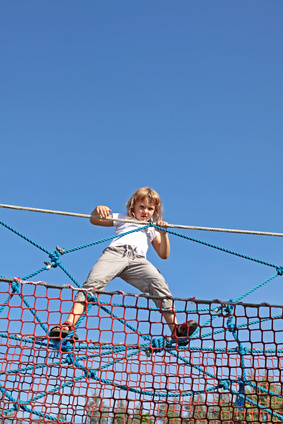Let Them Take A Risk

I hadn’t noticed until someone mentioned it. We were at a playground and there were no teeter-totters. My kids would not learn the thrill of teetering at the high end of the teeter-totter before plummeting back to the ground at a speed slightly quicker than imagined. There were also no merry-go-rounds, the ones you can get spinning so fast that the centrifugal force threatens to pull you right off the ride. I used to love the feeling of having to hold on for dear life and surviving before bursting into hysterical laughter! No, none of that in this playground. Instead, we stood on a large, soft rubber mat surrounded by mulch. The rides included enclosed stairs and “castle peaks, short slides, and balancing beams two inches off the ground. Don’t get me wrong. This was an amazing playground and my children loved it. Their favorite ride, though, was the spinning tire swing. My children loved to get on that swing beg me to spin them so fast their hair would fly straight back. Some parents wouldn’t allowed their children to ride at the fast spin, directed them to the slides and the castles. But my girls loved the thrill of holding on as the force of spinning pulled them outward. I just liked watching their hair fly back as they spun.
This memory came to mind as I read a review of the literature on play and anxiety published in Evolutionary Psychology. This review suggested that “risky play,” like the playground rides described above, help to prevent long-term anxiety. The article notes that we have become a society in which anxiety is epidemic and the overprotection of children may contribute to that increase in anxiety. Risky play, play in which we go right to the edge of safety, may help prevent anxiety. It helps us become more aware of our environment and our personal limitations. The more we know about our surroundings and the more comfortable we become with exploring new things, the less anxiety will hold us back. The more we know about our personal limitations, the more we practice healthy caution rather than anxious avoidance. But risky play does more than increase our awareness. It also represents a form of “exposure therapy,” an opportunity to face our anxiety in a healthy, appropriate manner and overcome the fears that threaten to imprison us. For instance, climbing trees teaches us to interpret the feelings associated with greater heights as information rather than simple anxiety that holds us back and “keeps us on the ground.” We can make wise decisions based on our experienced-based knowledge of the environment (strong vs. weak branches) and our own ability. This comfort with heights translates from trees to bridges to rooftops to airplanes. We learn to think wisely about our actions and related fears rather than succumbing to irrational anxieties.
So, what kind of risky play can help your children avoid anxiety? Here are six categories identified in the literature review.
- Exploring heights by doing things like climbing trees, jumping, balancing or swinging.
- Exploring speed as we speed along on our bikes, skates, sliding, etc.
- Learning about dangerous tools by using knives, ropes, or tractors for various activities.
- Rough-and-tumble play, like wrestling, play fighting, or sword fighting with sticks, helps us learn to negotiate physical interactions with others.
- Exploring “dangerous elements” like deep water, icy water, fire, or rock climbing.
- “Getting lost” and exploring our communities and world.
Of course, we don’t want our children to go crazy. We still need to teach our children the difference between risky behavior and hazardous behavior. However, when the opportunity arises, let your children engage in some risky play. Let them poke the fire. Let them climb the tree. Encourage them to do some rock climbing, wood chopping, vegetable cutting, and swimming in the deep end. Let them explore. You may be preventing the rise of anxiety and opening the door for them to live a more joyous life.
-0 Comment-